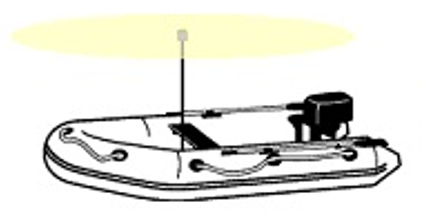Boating rules
International boating rules must be followed if you are operating on South Australian waters. Rules on giving way, warning signals, distress signals, navigation lights and recognising buoys, beacons and marks are vital to navigating safely on all waters. You can test your knowledge of these rules by using these resources:
- Practice the boat licence test online
- Test if your boating knowledge is seaworthy by having a go at our Marine Safety quiz.
- Read the online South Australian Recreational Boating Handbook.
Even if you already have your boat licence, it is always good to refresh your knowledge of the boating rules before heading out on the water.
![]()
Giving way
If you are required to give way to another vessel, take early and positive action so that your intentions are clear. Avoid making a series of small changes in speed or course that may not be apparent to the other vessel.
If another vessel is required to give way to you, maintain your present speed and course unless it is obvious that a collision may occur. In this case stop, slow down or turn away.
Rivers and channels
All vessels - including sail vessels - must always be navigated on the right (starboard) side of a river or channel in the direction of travel.
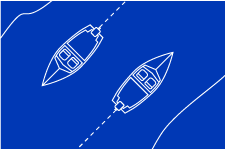
Sailing and power-driven vessels crossing
Powered vessels normally give way to sail. However, in harbours and channels where there is restricted room, small sailing vessels must give way to large powered vessels that cannot easily manoeuvre. Similarly, sailing vessels must also give way to other vessels that are restricted in their ability to manoeuvre, including fishing vessels that may have nets or other equipment over the side.
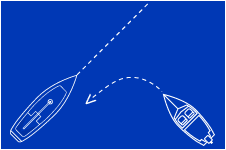
Power-driven vessels meeting head-on
Each vessel must alter course to the right (starboard) so as to pass on the port side of the other.
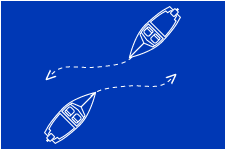
Vessels overtaking
An overtaking vessel (including a sailing vessel) may pass on either side if safe, but must keep well clear of the vessel being overtaken.
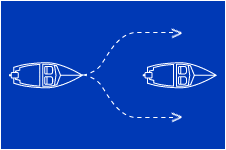
Navigation lights
Requirements for power and sailing boats
Vessels underway at night must show navigation lights between sunset and sunrise. Navigation lights indicate:
- presence of a vessel
- approximate direction of travel
- type of the vessel ie - power-driven or sailing.
Inland Navigation Rules are nearly identical to the International Rules, so we will describe the International Rules to simplify the choices.
Basic rules:
- Side lights are red (port) and green (starboard) and shine from dead ahead to 112.5° aft on either side.
- Stern lights are white and shine aft and 67.5° forward on each side. (Therefore, the side lights and stern light create a full circle of light.)
- All-round lights are white and shine through 360°.
- Masthead lights are white and shine from 112.5° on the port side through dead ahead to 112.5° on the starboard side. They must be above the side lights.
- Sailboats under power are considered powerboats.
- Side lights may be combined into a single "bicolor" light.
- Powerboats less than 20m (65.5') in length need to show side lights, a stern light and a masthead light. Power vessels less than 12m may show a single all-round light in lieu of the separate masthead and stern lights.
- Sailing vessels less than 20m in length need to show side lights and a stern light. These may be combined into a bicolor light and stern light, or a single tricolor light at the top of the mast. Sailing vessels under 7m must have an electric torch or lantern available for collision avoidance.
- When anchored outside a special anchorage, power and sail vessels under 20m must display an all-round light. Vessels under 7m are exempt, unless anchored in a narrow channel or anchorage, or where other vessels usually navigate.
Small rowing and sailing boats
Small rowing and sailing boats are the only vessels that don't need navigation lights when operating at night, but operators of these vessels must instead carry a torch or lantern showing a white light and show it in sufficient time to prevent a collision.
Under 12 metres in length
Vessels under 12 metres in length use lights in various combinations, depending on whether the vessel is sail or power-driven, underway or at anchor.
Power-driven vessels while underway
Power-driven vessels while underway must show either:
- a masthead light, separate or combined sidelights and a sternlight or
- a white light visible all round and separate or combined sidelights, provided that the all-round white light is positioned so as not to interfere with the operator's vision.
The masthead or all-round white light must be a minimum of one metre above the sidelights.
Lights required for power vessel underway
| Vessel length | Typical appearance | Lighting requirements |
|---|---|---|
| Under 7 metres and less than 7 knots |
| Must exhibit a white all round (360 degree) light and, if possible separate or combined sidelights |
| Under 12 metres | 
| Must exhibit one of the following: or - Separate or combined sidelights and an all round white light. Masthead or white all round light shall be carried at least 1 metre above the sidelights. |
| 12 metres to 20 metres | 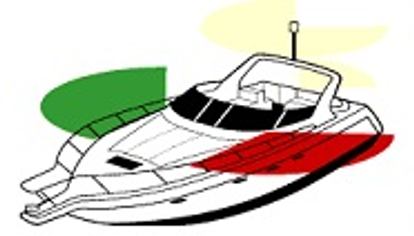
| Must exhibit one of the following: - A masthead light, separate sidelights and stern light. or - A masthead light, combined sidelights and stern light. The masthead light shall be carried at least 2.5 metres above the gunwale. Combined sidelights shall be carried at least 1 metre below the masthead light. |
Sailing vessels while underway
Sailing vessels while underway must show:
- separate or combined sidelights and a sternlight or
- a single, tri-colour lantern, fixed to the masthead.
Lights required for non-powered vessel underway
| Vessel length | Typical appearance | Lighting requirements |
|---|---|---|
| Under 7 metres | 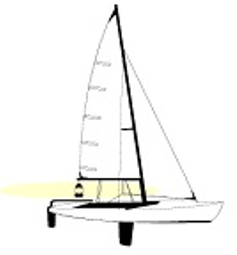
| Must exhibit the lights required for sailing vessels over 7 metres. If not, they should have an electric torch or lighted lantern showing a white light which shall be exhibited in sufficient time to prevent collision. |
| 7 metres to 20 metres | 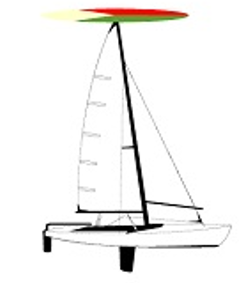
|
Must exhibit one of the following: - Combined lantern, that is at or near the top of the mast and incorporates sidelights and stern light. or - Separate sidelights and stern light. |
| Over 20 metres | 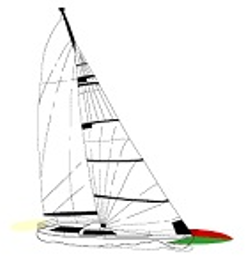
|
Must exhibit sidelights, stern light and may carry the optional red and green all round lights. Note - these vessels may not carry a combined lantern. |
| Optional | 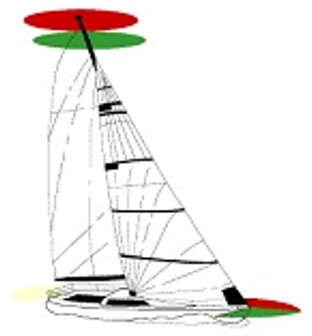
| A sailing vessel of any length, which is fitted with sidelights and a stern light (but not a combined lantern) may, in addition, carry two all round lights in a vertical line at or near the top of the mast. The upper light shall be red and the lower light green. |
Vessels at anchor - sail or power-driven
Vessels at anchor, either sail or power-driven, must show a single white light visible all round.
Lights required for vessels at anchor
| Vessel length | Typical appearance | Lighting requirements |
|---|---|---|
| Under 50 metres | 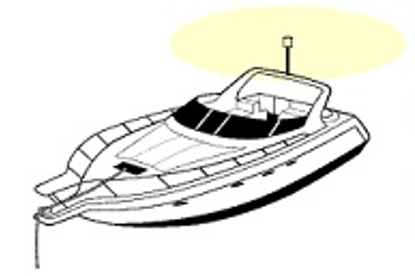
|
Must exhibit an all round white light placed where it may best be seen. Anchor lights must always be shown from sunset to sunrise. If you are at anchor or in a busy area, then show additional lights to ensure you are seen and keep a good watch. |
Dredge signals
Vessels undertaking dredging, diving or underwater operations display either two black diamonds in daylight hours or two green lights at night to indicate the side on which it is safe for other vessels to pass.
This is the only time when red and green lights may not indicate a vessel's direction of travel.
A dredge also displays either two black balls in daylight hours or two red lights at night on the side where dredging is taking place - to indicate where it's unsafe to pass.
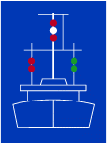
Dredge at night
Tips for installing navigation lights
By law, navigation lights and their installation on recreational boats are required to comply with the positioning and technical requirements of an international agreement, commonly known as the International Regulations for Preventing Collisions at Sea (COLREGS).
Marine Safety Authorities enforce the requirements of the COLREGS.
These guidelines have been developed for power boats less than 20 metres in length and can help you:
- Select the right lights for your boat.
- Avoid common problems when locating lights.
- Wire lights up correctly.
Avoiding damage
- Navigation lights must be installed in accordance with the manufacturers' instructions.
- Navigation lights should be mounted so as to minimize damage by contact with other objects under normal operating conditions.
- Lights mounted on the topsides of smaller craft can be damaged when coming alongside a wharf or pontoon.
- Lights mounted at the bow near anchor fittings could also be vulnerable and need to be protected.
Lights affecting the operator's vision
- Navigation lights must be installed to prevent the lights from shining into the operator's eyes.
- For open boats, this can be achieved by using a shielded light on a mast or pole.
- This could also be achieved by placing the light support behind the operator and above head height, rather than in the bow or amidships.
- Some LED lights are less prone to affecting night vision than conventional incandescent lights.
Wiring
- Navigation light wiring must be installed in accordance with a recognised wiring code.
- A white cable is normally used from the switch to the light and black is used for the return or negative conductor.
- The circuit should be fitted with a fuse or circuit breaker and no other equipment, apart from navigation lights, should be on that circuit.
- Conductors used for wiring must be sized to ensure no more than a 3% voltage drop.
- The lights should be wired so that one position of the switch turns on all the required running lights and a different position turns on just the anchor light.
- Alternatively, two switches that achieve this same result could be used.
Which light fittings to use
The Australian Maritime Safety Authority maintains a register of compliant safety equipment that includes navigation lights. If you choose to fit a light that isn't on the register, make sure that it meets the performance requirements of the COLREGS. Pay particular attention to the shielding arrangements to ensure the light only shines in the correct direction and there is no overlap on combination lights.
All round white light
- An all-round white light shows over a nominal arc of the horizon of 360°.
- The light fitting must be located at least one metre above the sidelights; and should as far as practicable, be on the centreline of the boat.
- As a general rule, an all round white light should not be obscured by masts or other structures by more than 6° of arc. If that's not possible, or the light would shine into the operator's eyes, a masthead light in combination with a stern light is an alternative to an all round white light.
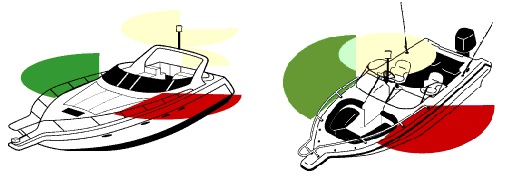
Masthead light
- Boats over 12 metres in length are required to have a white masthead light, mounted at least 2.5 metres above the gunwale that shines forward over an arc of the horizon of 225°, so that it can be seen from ahead of the boat to just aft of the beam.
- In addition, regardless of the vessel's length, the masthead light must be located at least one metre above the sidelights; and should as far as practicable, be on the centreline of the boat.

Stern light
- A stern light is located near the stern to show a white light over an arc of the horizon of 135° behind the boat.
- On an outboard craft, it may be necessary to mount the stern light on a mast, or to one side of the boat, to avoid the motor obscuring the light.
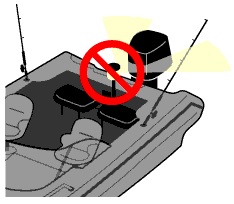
Side lights
Most boats need to have a port (red) and a starboard (green) side light each showing an unbroken light over an arc of the horizon of 112.5° from dead ahead to slightly after of the beam on either side.
If the design of the boat allows, a combination port and starboard light unit can be mounted on the centreline of the boat, in place of two individual side lights.
Individual side lights come in two styles:
- Mounted on a horizontal surface such as a deck:
- Horizontally mounted side lights generally come with a reference line marked on them which must be kept parallel to the centreline of the boat when fitting the light.
- Mounted on a vertical surface such as the topsides or the side of the cabin.
- Vertically mounted side lights must be fitted with the back of the light parallel to the centre line of the vessel so that the light will be visible in the correct sector and the lights don't cross over.
- This means when lights are mounted on a vertical or near vertical surface that is not parallel to the centre line or not vertical, a wedge or similar must be provided to achieve the correct alignment in both planes.
Be careful not to mount lights on a horizontal surface if they are designed to be mounted on a vertical surface, and vice-versa, because they will shine in the wrong direction.
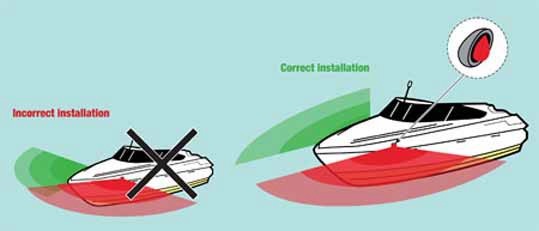
Range of visibility of lights
Minimum visibility for length of vessel (nautical miles)
| Vessel length | Masthead light | Side light | Stern light | All round lights |
|---|---|---|---|---|
| Under 12 metres | 2 miles | 1 mile | 2 miles | 2 miles |
| 12 metres to 20 metres | 3 miles | 2 miles | 2 miles | 2 miles |
| Under 12 metres | 2 miles | 1 mile | 2 miles | 2 miles |
| Light | Masthead light | Side light | Stern light | All round light |
|---|---|---|---|---|
| Colour | white | red / green | white | white |
| Angle of visibility | 225o | 112.5o | 135o | 360o |
As with channel and other lateral markers, the green sidelight indicates starboard and red indicates port, when looking in the direction of travel.
Distress signals
Distress signals must be used only to indicate need of assistance. Misuse of them may put the lives of others at risk and is illegal.
The following signals may be used to indicate distress.
- Rockets or shells that throw red stars, fired into the air one at a time at short intervals.
- A signal:
- made by radiotelegraphy or by any other signalling method consisting of the letters S O S in Morse Code (*** — — — ***)
- sent by marine radio consisting of the spoken word: MAY-DAY. See using marine radio.
- A square flag having above or below it a ball or anything resembling a ball.
- A rocket parachute flare or a hand-held flare showing a red light. See flares.
- A smoke signal giving off orange-coloured smoke.
- Slowly and repeatedly raising and lowering arms outstretched to each side.
- A rectangle of international orange-coloured material with either a:
- black letter V
- black square and circle, or
- dye marker.
- The International signal of distress indicated by N.C .

- Continuous sounding of any fog-signalling apparatus.
- Signal transmitted by an Emergency Position Indicating Radio Beacon (EPIRB). See EPIRBs.
Warning signals
Large vessels sound a series of specific signals to indicate their intentions to other vessels in the vicinity. Some of the more common signals are listed below.
Short blast - about one second duration
Prolonged blast - four to six second duration
| Description | Signal |
|---|---|
| I am altering my course to starboard | One short blast on a horn or similar device. |
| I am altering my course to port | Two short blasts on a horn or similar device. |
|
I am operating astern propulsion engines in reverse - vessel slowing down, stopping or intends going astern | Three short blasts on a horn or similar device. |
| Signal by vessel in doubt as to the intentions of the other vessel | Five short blasts on a horn or similar device. |
| Vessel nearing a blind bend in a channel or river | One long blast on a horn or similar device. |
Diver below flag
The signal flag for the letter 'A' shown below is used internationally to indicate 'I have a diver below - keep well clear at slow speed'.
- The flag is coloured white and blue and may be displayed either from a vessel or floating buoy.
- It is an offence in South Australia to exceed four knots within 50 metres of a vessel or buoy displaying this flag.
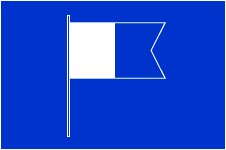
Buoys, beacons and marks
Isolated danger marks
- Isolated danger marks are placed on, or moored above, an isolated danger of minimal area below the water around the mark. The water around the mark is safe to navigate.
- The colours are red and black horizontal stripes and the mark is, when practicable, also fitted with a black top mark of two vertically aligned spheres.
- Isolated danger marks are not always positioned centrally over a danger so to be safe do not pass too close to the mark.
- If the mark is lit, the light will be white showing a group of two flashes. Two white flashes of light is the equivalent of two spheres.
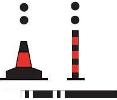
Safe water marks
- Safe water marks show that there is navigable water all around the mark and can be used as a centre line, mid-channel or landfall buoy.
- The shape of the buoy is spherical, pillar or spar (a round pole shape) and is coloured with red and white vertical strips. The top mark that's fitted when practicable to pillar and spar buoys, is spherical and red.
- If lit, it shows an isophase occulting or single long flashing white light. (An isophase is a special class of light which alternates eclipses and flashes of exactly equal duration).
- The buoy shape is optional but should not be in conflict with the buoy used for a lateral or special mark.
- Operators of vessels are cautioned that large commercial vessels may pass close by these marks.
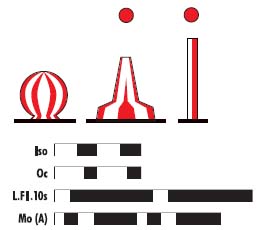
Channel markers
Channel markers indicate the port and starboard limits of a narrow channel that has been dredged in a river or the approaches to a harbor to allow safe passage of large vessels.
- The waters outside the channel may be shallow or conceal rocks and other hazards to navigation.
- Navigating outside the marked channel could result in a vessel running aground and sustaining serious damage.
- Entrances to harbors or breakwaters may use different distinguishing characteristics, for example, white flashing lights.
Types of markers
Two types of marker are used to indicate the port and starboard limits and these may be either fixed or floating.

The positioning of the two types of marker is determined by the general direction taken by a vessel when entering a harbour or proceeding upstream.
- Entering a harbor or proceeding upstream - under this convention a vessel entering, for example, the Port Adelaide River would keep the port (red) markers on her port side and the starboard (green) markers on her starboard side.
- Leaving a harbor or proceeding downstream - the situation is reversed, meaning that the port markers should now be passed on the vessel's starboard side and vice-versa.
Day marks
Day marks are shown by day in all weathers on boats to denote certain situations that may limit the vessel's ability to respond to other vessels, including when visibility is restricted, and must be recognised by vessel operators.
| Daymark | Daymark meaning | Details |
|---|---|---|
 Black ball, black diamond and black ball. | Vessel is restricted in its ability to manoeuvre | For example boats engaged in cable laying, replenishment at sea, underwater operation, servicing navigation marks or towing, where towing affects the manoeuvrability. |
One black ball. | Vessel at anchor | Not required for boats of less than seven metres. Used when at anchor not in a channel or channel approach, or a usual anchorage. |
 One black cone, point down. Located forward, where best seen. | Vessel under power with sails set | |
 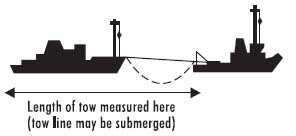 One black diamond on each vessel where best seen if length of tow exceeds 200 metres. | Power-driven vessel towing another vessel | |
 Three black balls. Located where best seen. | Vessel aground | Not required for boats of less than 12 metres. This signal does not indicate distress or a need for help. |
 Two black balls. Located where best seen. | Vessel not under command | Not required for boats of less than 12 metres. Indicates an inability to manoeuvre, but does not signal distress or a need for help. |
 Two black cones. | Boats fishing | Indicates trawls, nets or other gear - underway or at anchor, point inwards. If fishing vessel is less than 20 metres, she may instead show a basket. |
 One cylinder. Located where best seen. | Vessel constrained by her draught | Indicates a power-driven vessel restricted to a narrow channel by her draught and therefore unable to deviate from course. |
Port closed or channel blocked signal
The port closed or channel blocked signal is used to indicate a thoroughfare to navigation that's blocked. The signal may come from a shore station or from any vessel that's blocking the channel.
 | The marks are made up of three black shapes in a vertical line. The highest and lowest of these shapes shall be a ball and the middle on a cone with apex upwards. |
| Three all round lights in a line where they can be best seen. The highest and lowest of these lights shall be red and middle light shall be green. |
Cardinal marks
A cardinal mark indicates where the safest water may be found and is best used together with a compass. It shows where the mariner can safe pass safely and may:
- indicate the deepest water in an area
- show the safest side to pass a danger
- draw attention to a feature in a channel such as a bend, junction or an end of a shoal.
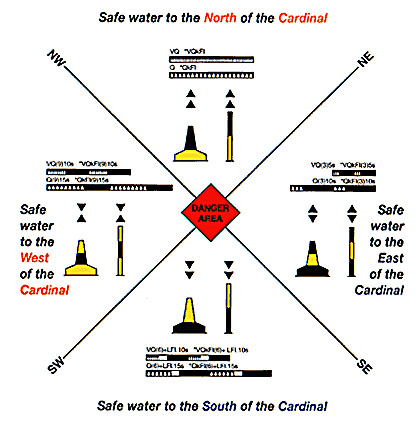
Think of a clock face when remembering the lights on cardinal marks. Three flashes for east, six flashes for south and nine flashes for west.
By day the colour scheme can be remembered by noting that the black segment is positioned where the cones point.
- North - the top mark points up and black segment is at the top
- East - the top marks point outward and there are black segments top and bottom
- South - the top mark points downward and the black segment is at the bottom
- West - the top marks point inward and the black segment is in the middle.
Top marks
Black double cones, clearly separated.
Colours - black and yellow horizontal bands with the position of the black band or bands relative to the respective cardinal points.
| North | Top mark points up, black band above yellow band. | |
| East | Top mark points outward, black bands above and below yellow band | |
| South | Top mark points down, black band below yellow band | |
| West | Top mark points inward, black band between yellow bands |
Special marks
Special marks are used to point out a special area or feature on the water. The nature of the area or feature may be found by consulting a chart or sailing directions of the area.
Special marks are always yellow and the top mark, if fitted, is a single yellow X. If a light is fitted it will be yellow and may have any rhythm not used for white lights.
In South Australian waters special marks are commonly used to indicate no boating zones or speed restricted areas.
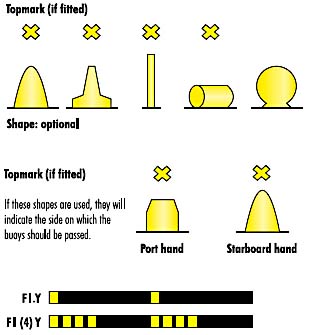
Lateral marks
Lateral marks are usually positioned to define well-established channels and indicate port and starboard sides of the navigation route into a port.

Port mark is coloured red and the basic shape is a can.

Starboard mark is coloured green and the basic shape is conical.

By night a port buoy shows a red light and a starboard buoy shows a green light.

